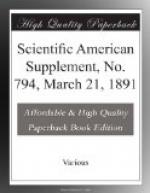It might be suggested that the reason why these plasters set more slowly than completely dehydrated plaster is owing simply to the fact that they contain, apparently, some unaltered gypsum, which serves to dilute the action. Were this so, a similar result, as far as time of setting is concerned, should be obtained with a plaster containing a corresponding quantity of dead-burnt material. This, however, is not found to be the case. The time of setting appears, then, to be connected in some special and peculiar manner with the retention of water by the burnt plaster.
The following explanation of this connection is offered, an explanation only tentative at present, owing to want of experimental data.
The following substances are known:
Gypsum, and set plaster, CaSO4
+ 2 H2O, containing 20.93
per cent. of water.
Plaster completely burned
at moderate temperature, CaSO4,
probably amorphous.
Anhydrite and dead-burned plaster, CaSO4, crystalline.
Selenitic deposit from boilers,
2 CaSO4 + H2O, or CaSO4 +
1/2 H2O, containing 6.2 per
cent. of water.
The circumstance that the hot calcium sulphate can crystallize with 1/4 its normal amount of water indicates that for this proportion of water it has a greater attraction than for the other 3/4. Having a similar bearing is the fact that when burned at lower temperatures, gypsum only loses the last portions of water with extreme slowness.
Now, if it be the case that anhydrous calcium sulphate has a greater attraction for the first half molecule of water, then the operation of hydration will proceed very rapidly at first, more slowly afterward. Many such cases are known, e.g., that of copper sulphate. Conversely, if only 3/4 of the water of hydration be expelled during the baking of gypsum, the material obtained should hydrate itself more slowly. For our present purpose it will be convenient to recalculate the numbers given by Landrin (vide supra) so as to make the calcium sulphate and water add up to 100. This treatment of the numbers gives a mean result for the six analyses of 7.68 per cent. of water, the amounts not varying by more than 1 per cent.
It will be seen that the dehydration has never passed the composition corresponding to 2 CaSO4 + H2O; indeed, the material approximates more nearly to the composition 3 CaSO4 + H2O. It appears probable, therefore, that in the successful preparation of plaster the whole, or nearly the whole, of the gypsum is changed, but that this change does not result in the production of CaSO4, or of a mixture of CaSO4 and CaSO4 + 2 H2O, but of a lower hydrate of calcium sulphate.
In the case of the analyses, given by Landrin, of fine plaster for potteries, the percentages of water (8.14 and 8.08) correspond closely to that of a hydrate, 3 CaSO4 + 2 H2O, which would contain 8.1 per cent. of water.




